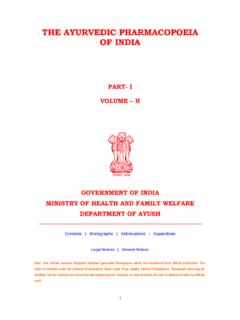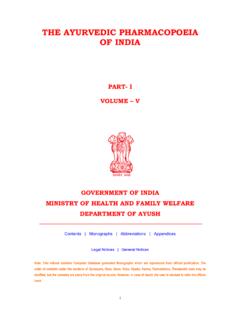Transcription of THEORY OF AYURVEDA (An Overview)
1 THEORY OF AYURVEDATHEORY OF AYURVEDA ( an overview )(An Overview) Dr Dr ChakraChakraPanyPanySharmaSharmaM. D. (M. D. (AyuAyu), PhD (), PhD (SchSch))READERREADER--PGPGMMM MMM GovtGovtAyurvedaAyurvedaCollegeCollegeUd aipurUdaipur--IndiaIndia313001313001 Email: Email: BrhamaLord Dhanvantari-The Father of SurgeryAn overview of Lake City an overview of Lake City UdaipurUdaipurFatehsagar Lake and Island ParkGreenery in Rural AreaClouds over the Peak of MountainNight Scenario of Fountain ParkIntroduction & BackgroundIntroduction & BackgroundAyurvedaAyurveda((DevanagariDe vanagari: : ) or ) or AyurvedicAyurvedicmedicinemedicineis an ancient system of health care is an ancient system of health care that is native to the that is native to the Indian subcontinentIndian subcontinent. It is . It is presently in daily use by millions of people in presently in daily use by millions of people in IndiaIndia, , NepalNepal, , Sri Sri LankaLanka,China,China, Tibet, and , Tibet, and Pakistan.
2 It is now in practice for health care in Pakistan . It is now in practice for health care in EuropianEuropiancountries. The word "countries. The word "AyurvedaAyurveda" is a " is a tatpurushatatpurushacompound of the word compound of the word yusyusmeaning meaning "life" or "life principle", and the word "life" or "life principle", and the word vedaveda, which , which refers to a system of "knowledge". refers to a system of "knowledge". to According to CharakaCharakaSamhitaSamhita, "life" itself , "life" itself is defined as the "combination of the body, is defined as the "combination of the body, sense organs, mind and soul, the factor sense organs, mind and soul, the factor responsible for preventing decay and responsible for preventing decay and death." death." According to this perspective, According to this perspective, AyurvedaAyurvedais is concerned with measures to protect concerned with measures to protect ""ayusayus", which includes healthy living along ", which includes healthy living along with therapeutic measures that relate to with therapeutic measures that relate to physical, mental, social and spiritual physical, mental, social and spiritual harmony.
3 Harmony. (the "descent of (the "descent of AyurvedaAyurveda") ") BrahamaBrahamaDakshaDakshaPrajapatiPraja patiIndraIndraBharadwajBharadwajBharadva jaBharadvajain turn taught in turn taught AyurvedaAyurvedato a group of to a group of assembled sages, who then passed down different assembled sages, who then passed down different aspects of this knowledge to their studentsaspects of this knowledge to their students.. to tradition, According to tradition, AyurvedaAyurvedawas first was first described in text form by described in text form by AgniveshaAgnivesha, , named named --AgniveshAgniveshtantratantra. The book was . The book was later redacted by later redacted by CharakaCharaka, and became , and became known as the known as the CharakaCharakaSamhitSamhit .. Another early text of Another early text of AyurvedaAyurvedais the is the SushrutaSushrutaSamhitSamhit , which was compiled by , which was compiled by SushrutSushrut, the primary pupil of , the primary pupil of DhanvantriDhanvantri, , sometime around 1000 BC.
4 Sometime around 1000 BC. DhanvantriDhanvantriis is known as the Father of as the Father of Branches (Eight Branches (AshthangaAshthanga) of ) of AyurvedaAyurveda The eight branches of The eight branches of AyurvedaAyurvedaare:are: 1. Internal medicine 1. Internal medicine --KayachikitsaKayachikitsaTantraTantra 2. Surgery 2. Surgery --ShalyaShalyaTantraTantra 3. Ears, eyes, nose and throat 3. Ears, eyes, nose and throat --ShalakyaShalakyaTantraTantra 4. Pediatrics 4. Pediatrics --KaumarabhrityaKaumarabhrityaTantraTant ra 5. Toxicology 5. Toxicology --AgadaAgadaTantraTantra 6. Purification of the genetic organs 6. Purification of the genetic organs --BajikaranaBajikarana(or (or VajikaranaVajikarana) ) TantraTantra 7. Health and Longevity 7. Health and Longevity --RasayanaRasayanaTantraTantra 8. Spiritual Healing/Psychiatry 8. Spiritual Healing/Psychiatry --BhutaBhutaVidyaVidyaMotto of Motto of AyurvedaAyurvedaMotto of Motto of AyurvedaAyurvedais : is : SWASTHASYA SYASTHYA SWASTHASYA SYASTHYA RAKSHANAM, AATURASHCHA VIKAR RAKSHANAM, AATURASHCHA VIKAR PRASHAMANAM , PRASHAMANAM , means:means: Preservation to health of healthy person Preservation to health of healthy person and treating ailments with breaking and treating ailments with breaking causative factors of pathogenesis.
5 Causative factors of pathogenesis . Basic Principles of Basic Principles of AyurvedaAyurvedaAyurvedaAyurvedais based on the following is based on the following theories : theories : 1. 1. PanchaPanchaMahabhutaMahabhutaTheoryTheo ry(Five Elements)(Five Elements)2. Tri2. Tri--doshadoshatheorytheory(Three Body Humors)(Three Body Humors)3. 3. SaptaSapta--dhatudhatutheory THEORY (Seven Body Tissues) (Seven Body Tissues) PanchamahabhootPanchamahabhootTheoryTheo ryThe basic premise of The basic premise of AyurvedaAyurvedais that the entire is that the entire cosmos or universe is part of one singular cosmos or universe is part of one singular absolute. Everything that exists in the vast absolute. Everything that exists in the vast external universe (macrocosm), also appears in external universe (macrocosm), also appears in the internal cosmos of the human body the internal cosmos of the human body (microcosm).
6 The human body consisting of 50(microcosm). The human body consisting of 50--100 million cells, when healthy, is in harmony, 100 million cells, when healthy, is in harmony, selfself--perpetuating and selfperpetuating and self--correcting just as the correcting just as the universe is. The ancient universe is. The ancient AyurvedaAyurvedatext, text, CharakaCharaka, , says, "Man is the epitome of the universe. Within says, "Man is the epitome of the universe. Within man, there is as much diversity as in the world man, there is as much diversity as in the world outside. Similarly, the outside world is as diverse outside. Similarly, the outside world is as diverse as human beings themselves." In other words, as human beings themselves." In other words, all human beings are a living microcosm of the all human beings are a living microcosm of the universe and the universe is a living macrocosm universe and the universe is a living macrocosm of the human beings.
7 Of the human beings. PanchaPanchaMahabhutaMahabhutaTheoryTheo ry(Five Great Elements)(Five Great Elements)The The PanchaPanchaMahabhutaMahabhuta,,or "five great or "five great elements", of elements", of AyurvedaAyurvedaare: are: or BhumiBhumi((EarthEarth),),2. 2. ApApor or JalaJala((WaterWater), ), 3. 3. AgniAgnior or TejasTejas((FireFire), ), 4. 4. VayuVayuor or PavanPavan((AirAiror or WindWind), ), 5. 5. AkashaAkasha((AetherAether). ). Hence, Hence, AyurvedaAyurvedaadvocates : advocates : YatYatPindePinde, Tat , Tat BramhandeBramhande.. Concept of Concept of MahabhootMahabhootin Other in Other Civilizations Civilizations Classical Elements : Classical Elements : PanchamahabhootPanchamahabhoot WesternWesternAirAir,,Water, Water, AetherAether, Fire, Fire,,EarthEarth Chinese (Wu Xing)Chinese (Wu Xing): : Water, Metal, Earth, WoodWater, Metal, Earth, Wood, , FireFire Japanese (Japanese (GodaiGodai)): : EarthEarth, , WaterWater, , Fire, Air, WindFire, Air, Wind, , Void, Void, Sky, HeavenSky, Heaven Hinduism (Hinduism (TattvaTattva))and and Buddhism (Buddhism (MahMah bh tabh ta)): : VayuVayu/ / PavanPavan Air / WindAir / WindAgniAgni/ / TejasTejas FireFireAkashaAkasha AetherAetherPrithviPrithvi/ / BhumiBhumi EarthEarth JalaJala WaterWater B nB n: : AirAir, , Water, Space, FireWater, Space, Fire, , EarthEarth New ZealandNew Zealand.
8 AirAir, , Water, Flora, FireWater, Flora, Fire, , The GreekGreekclassical classical elements are elements are FireFire, , EarthEarth, , AirAir, and , and WaterWater.. They represent in They represent in Greek philosophyGreek philosophy, , sciencescience, and , and medicinemedicinethe realms the realms of the of the cosmoscosmoswherein all things wherein all things exist and whereof all exist and whereof all things According to According to GalenGalenthese elements were used these elements were used by by HippocratesHippocratesin describing the in describing the human bodyhuman bodywith an association with the with an association with the four four humourshumours: : yellow yellow bilebile(Fire), (Fire), black bileblack bile(Earth), (Earth), bloodblood(Air), (Air), and and phlegmphlegm(Water).(Water). Some Some cosmologiescosmologiesinclude a fifth element, the include a fifth element, the ""aetheraether" or "" or "quintessencequintessence.
9 " These five elements ." These five elements are sometimes associated with the five are sometimes associated with the five platonic platonic The The PythagoreansPythagoreansadded added ideaideaas the fifth as the fifth element, and also used the initial letters of these element, and also used the initial letters of these five elements to name the outer angles of their five elements to name the outer angles of their inscribed in a pentagram, from Man inscribed in a pentagram, from Heinrich Cornelius AgrippaHeinrich Cornelius Agrippa's 's LibriLibritrestresde de occultaoccultaphilosophiaphilosophia. The five signs at the . The five signs at the pentagram's pentagram's verticesverticesare are astrologicalastrological.. TridoshaTridoshaTheory THEORY The central concept of The central concept of AyurvedicAyurvedicmedicine is the medicine is the THEORY that health exists when there is a balance THEORY that health exists when there is a balance between three fundamental bodily between three fundamental bodily humourshumoursor or doshasdoshascalled called VataVata, , PittaPittaand and VataVatais the is the airairprinciple necessary to mobilize principle necessary to mobilize the function of the nervous system the function of the nervous system PittaPittais the is the firefireprinciple which uses bile to direct principle which uses bile to direct digestion and hence metabolism into the venous digestion and hence metabolism into the venous system.
10 System. KaphaKaphais the is the waterwaterprinciple which relates to principle which relates to mucous, lubrication and the carrier of nutrients mucous, lubrication and the carrier of nutrients into the arterial system. into the arterial system. In AyurvedicAyurvedicphilosophy, the five elements combine philosophy, the five elements combine in pairs to form three dynamic forces or interactions in pairs to form three dynamic forces or interactions called called doshasdoshas.. DoshaDoshameans "that which "that which changes." It is a word derived from the root " It is a word derived from the root dusdus, which is , which is equivalent to the English prefix 'equivalent to the English prefix 'dysdys', such ', such as in dysfunction, dystrophy, etc. In this sense, as in dysfunction, dystrophy, etc. In this sense, doshadoshacan be regarded as a fault, mistake, error, can be regarded as a fault, mistake, error, or a transgression against the cosmic rhythm.







